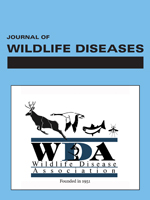Seven common wombats (Vombatus ursinus) were exposed and two of these were re-exposed to Sarcoptes scabiei var. wombati (Acari: Sarcoptidae). For wombats exposed for the first time, five exposed to 5,000 mites on their shoulder developed moderate to severe parakeratotic mange after 11 wk compared with two given 1,000 mites that developed mild clinical signs of mange after 11 wk. For re-exposed wombats, one of two given 5,000 mites developed mild parakeratotic mange and the other developed severe parakeratotic mange. Initial signs of mange were erythema followed by parakeratosis, alopecia, excoriation and fissuring of parakeratotic crust and skin. Erythema usually became apparent within 14 days after exposure (DAE) or within 24 hrs of re-exposure. Parakeratosis was visible 14–21 DAE and alopecia first occurred 35–77 DAE. Clinical signs increased in severity over time and lesions spread slowly from the site of exposure. Mangy wombats scratched excessively, lost weight, and exhibited a significant neutrophilia compared with control wombats. Treatment of mange with three injections of ivermectin, 300 μg/kg, 10 days apart led to complete resolution of clinical signs. However mites were not entirely eliminated until wombats received a second regime of treatment.
How to translate text using browser tools
1 January 2003
CLINICAL RESPONSE OF CAPTIVE COMMON WOMBATS (VOMBATUS URSINUS) INFECTED WITH SARCOPTES SCABIEI VAR. WOMBATI
Lee F. Skerratt

Journal of Wildlife Diseases
Vol. 39 • No. 1
January 2003
Vol. 39 • No. 1
January 2003
clinical pathology
clinical signs
common wombat
experimental infection
Sarcoptes scabiei
sarcoptic mange
Vombatus ursinus




